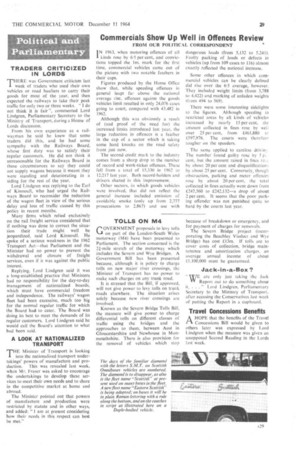Commercials Show Up Well in Offences Review
Page 31

If you've noticed an error in this article please click here to report it so we can fix it.
FROM OUR POLITIC AL CORRESPONDENT I N 1963, when motoring offences of all kinds rose by 6-5 per cent, and convictions topped the 1m. mark for the first time, commercial vehicles came out of the picture with two notable feathers in their 'caps.
Figures produced by the Home Office show that, while speeding offences in general leapt far above the national average rise, offences against the goods vehicles limit resulted in only 24,076 cases going to court, compared with 43,482 in 1962.
Although this was obviously a result of (and proof of the need for) the increased limits introduced last year. the large reduction in offences is a feather in the cap of a sector which is taking some hard knocks on the road safety front just now.
The second credit mark to the industry comes from a sharp drop in the number of record and work-ticket offences. These fell from a total of 15,330 in 1962 to 12;217 last year. Both record-holders and drivers shared in this improvement.
Other sectors, in which goods vehicles were involved, that did not reflect the general increase included emission of avoidable smoke (only up from 2,777 prosecutions to 2,867) and use with dangerous loads (from 5,132 to 5,241). Faulty packing of loads or defects in vehicles (up from 109 cases to 116) almost exactly reflected the national increase.
Some other offences in which commercial vehicles can be clearly defined did rise over the 6-5 average, however. They included weight limits (from 3,788 to 4,422) and marking of unladen weights (front 494 to 569).
There were some interesting sidelights to the figures. Although speeding in restricted areas by all kinds of vehicles increased by nearly 15 per cent, the amount collected in fines rose by wc1 over 25 per cent, from £461,880 te .F.597,976. The courts were therefore tougher on the speeders.
The same applied to careless driyinf The number found guilty rose by 5 pc cent, but the amount raised in fines roe by about 20 per cent and disqualifications by about 25 per cent. Conversely, though obstruction, parking and meter offence rose by about 20 per cent, the total collected in fines actually went down from 1247,560 to £242,132—a drop of about 2 per cent. It seems that the poor parking offender was not punished quite so hard by the courts last year.
















































































































